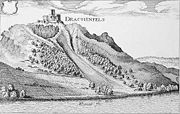

Drachenfels Castle as it looked in the 21st and 17th centuries (photo: S. Mense, engraving: M. Merian).
Hotel Du Géant ~ Last evening at six o’clock we left Cologne for Bonn by rail and past the night there. It is only one hours ride. Bonn is a lovely place, just upon the river, where it begins to be picturesque and commands a fine view of the seven hills, with the Drachenfells castle in the distance. We saw the river by moonlight last evening. Bonn is a fine looking city, looking somewhat like an American watering place, handsome houses, unpaved streets, large trees on either side etc. It contains a celebrated university in which Prince Albert was educated. The house is still shown there in which Bethoven was born. At ten o’clock we took an open carriage provided by our hotel and left Bonn en route up the river. The drive is delightful to Godesberg, a hill overlooking the river, crowned by a ruined castle built by one of the Archbishops of Cologne in the 13th century, on the site of a Roman fort. We made the ascent on Donkeys in about 15 minutes. Our donkeys were each led by little boys. The view from the top is magnificent, finer much than that from the Drachenfells. It is a hard scrambling ride but the view repays the trouble. Our little guides, when we arrived at the top, picked little bouquets for us, in hopes to increase their “drink geld.” The little asses seemed quite disproportionate to the load they bear. My feet almost touched the ground, on either side, when seated on one of them. They walk with great elasticity and force but do not like to trot. They seem to posses more sagacity than a horse and make a loud crying when displeased, which is very painful to unaccustomed ears. Continuing our drive up the river, we found we were traversing a road founded by Marcus Aurelius of Lucius Verus, 160 years after Christ. A few miles brought us to the foot of the Drachenfells, which we ascended on mules. The hill is very steep indeed and the road winds up through vineyards almost all the way. The ruined towers at the top and the view is not as fine as in many other places on the Rhine. Still it is beautiful. We took out Childe Harold and read the passages relating to this part of the river. At half past one we took a steamer and were soon sailing rapidly up the river, between very high and irregular banks. Just above Konigswinter on the opposite side rises a steep hill on which is the ruin of the castle of Rolandseck. The nephew of Charlemagne (Roland) built it to command a view of the convent where his betrothed had taken the veil. From a point a short distance above this the prospect is charming. One may see the ruins of the Drachenfells, Rolandseck Castle, on their separate heights and the convent below, besides several less important castellated summits. Farther up the river are the ruins of Hammerstein Castle, on a high rock just over the water. It was built in the 10th century and was besieged by the Swedes in the 30 years war. Still farther up we passed the white tower which marks the spot where Caesar crossed the Rhine when leading an army against the Sicambri and also where General Hoche crossed in 1797 in spite of the opposition of the Austrians. All these Rhemish hillsides are covered with grape vines which grow on terraces and which seem to be inaccessible to mortal foot. Many of these terraces are cut out of the solid rock and the soil has been carried up to them in baskits, on the heads of the peasants. The vines did not seem to us to add to the landscape as they are trained on straight poles only about four or five feet high, which appear merely like scrub bushes from the river below. We have been perfectly enchanted with our days voyaging. The Rhine is beautiful beyond description, more beautiful by far than the Hudson (setting aside the ruins) although there are some small portions of the Hudson that more than equal it in natural beauty. This part of the Rhine is narrower than the Hudson and the banks are far more precipitous, rocky, and the general scenery wilder. The white and red wines are very agreeable to one who is a little used to them. They are entirely without adulteration and admixture of alcohol here, that these wines always have in America and possess a purer taste. Lizzie and the girls do not like them because they are not accustomed to any acid wine. The price on board the Rhine boats is one franc to one and a half per bottle (20 to 30 cts). Last evening at Bonn we all went to a concert because Alice said she “wanted to hear some German music in a German land.” But the concert turned out to be only a four Tyrolian songs given by three or four natives in costume. It would have been decidedly common in America. The audience looked just as any well dressed one would in America. Thus far life seems much the same all over. At the hotels they always give us here a square pillow (about two feet square) stuffed with down as an extra covering. It is a very peculiar arrangement because it only covers half the body, and that only for half the night, for at the first turn it rolls off. We have not seen a double bed for a long while. We arrived this evening at Coblentz. Our rooms look out upon the river.
Childe Harrold refers to "Childe Harold's Pilgrimage" a long poem by Lord Byron.
ReplyDeletehttp://en.wikipedia.org/wiki/Childe_Harold%27s_Pilgrimage